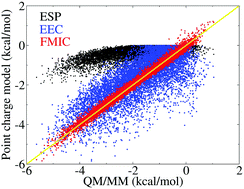A fixed multi-site interaction charge model for an accurate prediction of the QM/MM interactions†
Abstract
A fixed multi-site interaction charge (FMIC) model was proposed for the accurate prediction of intermolecular electrostatic interactions based on the quantum mechanical linear response of a molecule to an external electric field. In such a model, some additional off-center interaction sites were added for capturing multipole interactions for a given molecule. By multivariate least-square fitting analysis of the calculated QM/MM interactions of a given molecule with the electrostatic environment and the electrostatic potentials of the environment at the pre-defined distributed interaction sites, the FMIC of the molecule was obtained. The model system of CO in myoglobin (Mb) was utilized to demonstrate the derivation of the FMIC. The accuracy of FMIC in predicting the electrostatic interactions between CO and the Mb environment was investigated using 10 000 different Mb–CO configurations generated from the 400 ps QM/MM MD simulation. In comparison to the QM/MM calculations at the B3LYP/aug-cc-pVTZ/ff99SB level, the mean unsigned error (MUE) of the results based on the FMIC model was merely 0.10 kcal mol−1, and the root mean square error (RMSE) was only 0.13 kcal mol−1, which are significantly lower than the results predicted by the ESP charge model (MUE = 1.45 kcal mol−1, and RMSE = 1.7 kcal mol−1, respectively). The transferability of FMIC was tested by applying the obtained FMIC in the wild type Mb–CO system to the mutants of V68F and H64L Mb–CO systems. The MUEs of the obtained results for 10 000 different configurations are both smaller than 0.2 kcal mol−1 for the V68F and H64L Mb–CO systems in comparison to the B3LYP/aug-cc-pVTZ/ff99SB calculations, and the RMSEs are also lower than 0.2 kcal mol−1 for both mutants. The applications of FMIC were extended to model the electrostatic interactions between a hydrogen fluoride molecule and 492 waters in a truncated octahedron box; our study showed that the FMIC could give satisfactory results with a MUE of 0.12 kcal mol−1 and a RMSE of 0.16 kcal mol−1 in comparison to the B3LYP/aug-cc-pVDZ/TIP3P calculations for 10 000 different configurations generated using the 10 ns classical MD simulation. Therefore, the FMIC method provides an accurate and efficient tool for predicting intermolecular electrostatic interactions, which can be utilized in the future development of molecular force fields.



 Please wait while we load your content...
Please wait while we load your content...